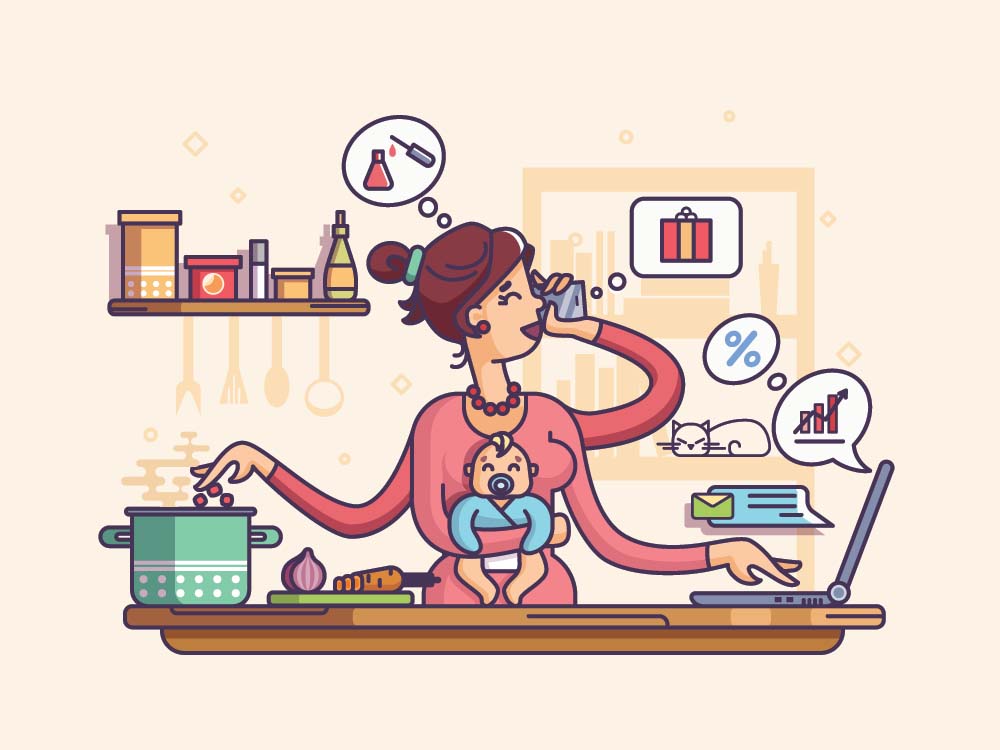She wakes up before everyone else in the family to sort out the household work. She ensures her kids are fed and ready to leave for school. And then, she gets ready for her workplace, to officially start her day as a part of the formalised labour force. While at work, she juggles just as much work as her peers are assigned—but unlike the others, her workday doesn’t end with her colleagues. This is because she goes home to resume her workload as a mother, and perhaps as a homemaker and spouse, as well as a primary caregiver for the entire family.
We call this woman a ‘working mother’. But should we?
The simplest answer to this question is a big, whopping NO. The term ‘working mother’ does very little justice to the woman described above. Moreover, it does no justice to other mothers who might not be a part of the formalised labour force. Here’s every reason why.
How The Term ‘Working Mother’ Came Up
The term ‘working mother’ hasn’t been around like some ancient relic, preserved for its great value in a museum. Before the 1950s, the term simply did not exist. During the Second World War and soon after it, the world went through an immense economic transition, which allowed the entry of women who are mothers and not fulltime homemakers into the formalised labour force. These women, especially in Western countries, were inevitably white and middle-class, and had taken up jobs to meet the growing demands of inflation and the impact it has on families.
In India, the term only came into vogue in the 1970s and 1980s, when mothers stepped out of their roles as homemakers to enter the formalised labour force—mostly in teaching and banking sectors. As the roles and opportunities expanded, these women continued to balance their homes and workplaces—or at least tried their best to—and are now given the titles of ‘working moms’, even ‘super moms’ because of the sheer amount of work they accomplish.

How This Term Gives Society An Easy Way Out
Giving labour force moms—because, let’s admit it, that’s the right way to address them—the epithet of ‘working moms’ or ‘super moms’ may seem like an act of genuine appreciation, but it’s really not. The term and the work these women do, after all, hides underneath it the disproportionate amount of work women, mothers or not, do in our everyday lives. The United Nations and UN Women have time and again brought spotlight to the fact that women do most of the unpaid domestic work and care work around the world. From caring for the elderly to the men, down to the children of the household, women do it all—whether she works in an office or not simply doesn’t come into play here, even in this day and age. On the other hand, her male partner or counterparts aren’t expected to maintain the balancing act between a paid job and unpaid domestic care work.
Giving her the presumably appreciative tag of ‘working moms’ somehow gives this disproportionately high amount of work she pulls off, often to the detriment of her own physical and mental health needs, the appearance of a good thing. In fact, if a woman does it all, it’s supposed to be a great thing, despite the fact that it’s simply not fair. Work, all work, should be equally distributed among all functional members of a family, right? If a woman is a part of the labour force and earning plenty to manage the economic aspect of the home front, then maybe the other members can share responsibilities, right? Current studies show this is perhaps a tall order.
According to a recent study published in the peer-review journal Work, Employment & Society, mothers who outearn their husbands also earn more household work—proving that instead of sharing the workload, these ‘working moms’ are getting even more work on their plates for being accomplished in their careers! Clearly, the epithet of ‘working moms’ is misleading and lets society get away with treating women’s labour like it’s a free-for-all.

A ‘Stay-At-Home Mother’ Is A Worker Too
On the other hand, a woman who isn’t defined as a ‘working mom’ is naturally assumed to be not a worker at all because she doesn’t get the big bucks home. What an immense disservice this is, especially since there isn’t a single person out there who can say that a ‘stay-at-home mom’ or homemaker isn’t just as hardworking as a so-called ‘working mother’! In fact, a 2018 study by the US juice company, Welch’s, shows that being a fulltime mom is the equivalent of holding 2.5 fulltime jobs! The study measured working hours, and found that while anybody with a fulltime job works eight to 10 hours a day, fulltime mothers work at least 14 hours a day.
Now let’s be fair here and add the other factors: a ‘stay-at-home mother’ also works on weekends and holidays, and doesn’t get paid a single rupee for all this labour. Let’s not forget that her domestic labour is part of the informal economy. Like the woman farmer whose labour isn’t recognised, hers isn’t either. In India, there is now at least an E-Shram portal which is working to bring female workers in the informal sector into the formalised system, but as yet, there is no accounting the work a ‘stay-at-home mother’ does—nor any monetary value attached to her labour. To know more about this, read our story on homemakers and their unpaid work.

Let’s Talk About Setting An Impossible Standard
Close your eyes and think about the popular image of a ‘working mom’. Neither is her home dirty nor do her kids have a hair out of place. Her bosses and colleagues at the workplace after always content with her performance because she’s naturally great at multi-tasking and managing it all. Everything on the home front and the work front is well-maintained, and every person is happy. This idealised picture of a ‘working mother’ and her surroundings might seem amazing in our minds, but it does put an immense amount of pressure on women to comply.
The simple fact is, maintaining one workplace is hard work. Juggling two is much harder and manic—not the hunky-dory picture we’re told to imagine. Not everyone is great at multi-tasking and even those who are good at it can have their bad days, because multi-tasking can be very draining indeed. Idealising the picture of the perfect ‘working mom’ or ‘super mom’ who does it all sets an impossible standard, a bar that every woman can feel guilty upon not meeting. For the ‘stay-at-home moms’, this idealised picture also does a lot of disservice because it permits many to say things like, “It’s good you only have to manage your home. You don’t have to handle the pressures of being a working mom.” Remember, we are not in their shoes, and these pressures do vary from one person to the other.

Where Are The Working Dads?
But if these reasons haven’t convinced you to strike out the term ‘working moms’—as well as the term ‘stay-at-home mom’—from your vocabulary permanently, here’s a more pertinent question for you. Why isn’t there a term equivalent to ‘working moms’ for men? Fathers are parents too. In this day and age, when companies and nations around the world are working to introduce paternity leaves so that men in the labour force can share the workload of raising a child, we need to accept the fact that work in the domestic sphere is not and cannot be limited to only women. It’s not just a question of women’s rights, but that of men too. It is, to put it simply and bluntly, a question of equal rights.
Over the last two years, while living during COVID-19 times, women across the world have come to realise that pandemic or not, household work falls disproportionately on them. Catering to the needs of kids and elders at home, whether you’re a labour force mom or a fulltime mom, has taught all of us that terms like ‘working moms’ and ‘stay-at-home moms’ do nothing but divide us when we should be united in asking for, rather claiming, identities that do justice to us and the labour we put in.